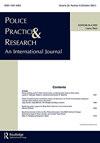澳大利亚警察对女性警察局的看法
IF 1.8
Q2 CRIMINOLOGY & PENOLOGY
引用次数: 1
摘要
为接收基于性别的暴力受害者而设计的妇女警察局于20世纪80年代首次出现在拉丁美洲。在阿根廷,这些监测站有其独特之处,如多学科人员配备,可以指导其他地方的应对工作。澳大利亚警方对家庭和家庭暴力(DFV)的反应不断使受害者失败,需要大量改进。将警察和其他服务结合起来的反应对澳大利亚来说并非完全陌生,而且与妇女警察局没有太大的不同。我们对澳大利亚警察进行了一项调查(n = 78),以评估阿根廷警察局的哪些方面可以为DFV警务的新方法提供信息。我们的调查发现,澳大利亚警方支持这种管理DFV的方法的某些方面,例如多学科站(74%)。对以女性员工为主的电视台的支持率明显较低(19%)。结合对澳大利亚同地反应评估的回顾,对实践的研究意义建议在澳大利亚进行更广泛的同地反应试验。本文章由计算机程序翻译,如有差异,请以英文原文为准。
Australian police perceptions of women’s police stations
ABSTRACT Women’s police stations that are designed to receive victims of gender-based violence first emerged in Latin America in the 1980s. In Argentina, these stations have unique aspects like multidisciplinary staffing that could guide responses elsewhere. Police responses to domestic and family violence (DFV) in Australia have continually failed victims and require much improvement. Responses combining police and other services are not completely alien to Australia, and are not too dissimilar from women’s police stations. We undertook a survey of Australian police (n = 78) to assess which aspects of Argentina’s stations could inform new approaches to DFV policing. Our survey finds that Australian police support some aspects of this approach to policing DFV, such as multidisciplinary stations (74%). There was significantly less support for stations staffed predominantly by women (19%). Combined with review of evaluations of Australian co-locational responses, research implications for practice suggest a broader trial of co-locational responses in Australia.
求助全文
通过发布文献求助,成功后即可免费获取论文全文。
去求助
来源期刊

Police Practice and Research
CRIMINOLOGY & PENOLOGY-
CiteScore
4.10
自引率
5.60%
发文量
50
期刊介绍:
Police Practice and Research is a peer-reviewed journal that presents current and innovative police research as well as operational and administrative practices from around the world. Articles and reports are sought from practitioners, researchers and others interested in developments in policing, analysis of public order, and the state of safety as it affects the quality of life everywhere. Police Practice and Research seeks to bridge the gap in knowledge that exists regarding who the police are, what they do, and how they maintain order, administer laws, and serve their communities. Attention will also be focused on specific organizational information about the police in different countries or regions. There will be periodic special issues devoted to a particular country or continent.
 求助内容:
求助内容: 应助结果提醒方式:
应助结果提醒方式:


